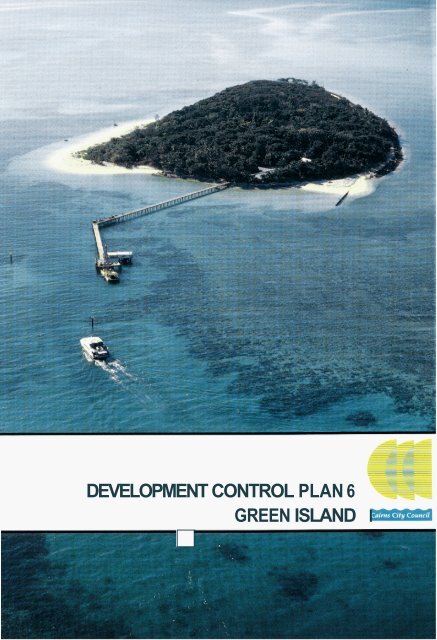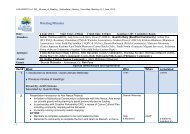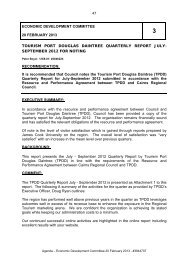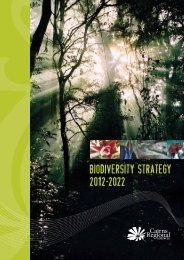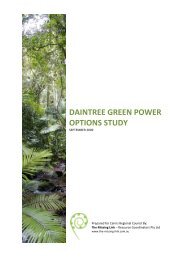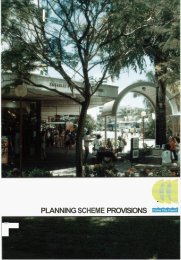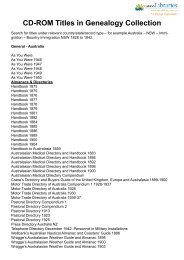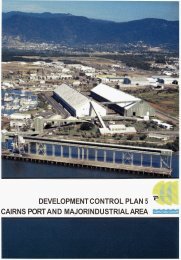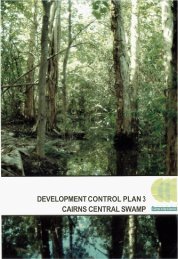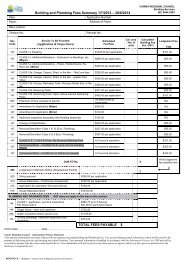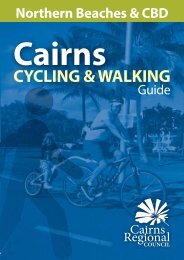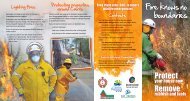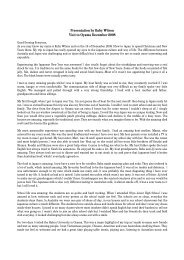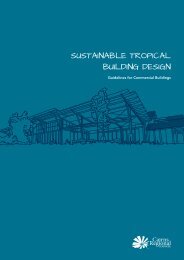development control plan 6 green island i - Cairns Regional Council
development control plan 6 green island i - Cairns Regional Council
development control plan 6 green island i - Cairns Regional Council
You also want an ePaper? Increase the reach of your titles
YUMPU automatically turns print PDFs into web optimized ePapers that Google loves.
DEVELOPMENT CONTROL PLAN 6<br />
GREEN ISLAND I
(000 17)<br />
DEVELOPMENT CONTROL PLAN 6<br />
GREEN ISLAND<br />
This Development Control Plan applies to the area shown on the Development Control Plan map<br />
marked Development Control Plan 6 Green Island and to any other areas included by way of<br />
amendment. This Plan should be read in conjunction with the Planning Scheme for part of the<br />
City of <strong>Cairns</strong> and is supplementary to that Scheme.<br />
Nothing in this Development Control Plan should be construed to confer any rights to use land<br />
for any purpose. Such rights remain vested in the provisions of the Zoning Maps and the<br />
Planning Scheme Provisions for part of the City of <strong>Cairns</strong>.<br />
This Development Control Plan includes the map described as Development Control Plan 6<br />
Green Island and is divided into the following :-<br />
1. Introduction<br />
2. Aim<br />
3. Objectives<br />
4. Precincts<br />
5.<br />
Performance Criteria Applicable to All Precincts<br />
6. Special Provisions<br />
Appendix I - Suitable Endemic Species for Green Island Landscaping<br />
PLANNING STUDY<br />
The Planning Study provides supporting information which is contained in that document<br />
marked Development Control Plan 6 - Planning Study, copies of the Study signed for<br />
identification by the Clerk of the Executive <strong>Council</strong> are held at the office of the Director of<br />
Housing, Local Government and Planning and at the office of the <strong>Cairns</strong> City <strong>Council</strong>. The<br />
Planning Study can be found in Part B of the Planning Scheme.<br />
December 1996
DEVELOPMENT CONTROL PLAN 6<br />
GREEN ISLAND<br />
CONTENTS<br />
PAGE<br />
1. INTRODUCTION 1<br />
2.<br />
3.<br />
AIM 1<br />
OBJECTIVES 1<br />
4.<br />
5.<br />
6.<br />
PRECINCTS 2<br />
4.1 Intent of Precincts<br />
4.1.1 Recreation Precinct<br />
4.1.2 Environment Precinct<br />
4.1.3 Tourism Precinct<br />
4.1.4 Infrastructue Precinct<br />
4.2 Implementation Provisions<br />
4.2.1 Recreation Precinct<br />
4.2.2 Environment Precinct<br />
4.2.3 Tourism Precinct<br />
4.2.4 Infrastructure Precinct<br />
PERFORMANCE CRITERIA APPLICABLE TO ALL PRECINCTS 13<br />
5.1 Vehicle Limitations<br />
5.2 Building Form and Construction<br />
5.3 Stormwater Discharge<br />
5.4 Building Materials<br />
5.5 Building Colours<br />
5.6 Construction of Pathways<br />
5.7 Signage<br />
5.8 Landscape Design<br />
5.9 Disaster Plan<br />
5.10 Termite Protection<br />
5.1 1 Chemical Storage<br />
SPECIAL PROVISIONS 18<br />
2<br />
2<br />
2<br />
2<br />
2<br />
2<br />
2<br />
3<br />
3<br />
8<br />
13<br />
13<br />
13<br />
13<br />
16<br />
16<br />
17<br />
17<br />
17<br />
17<br />
18<br />
APPENDIX I - SUITABLE ENDEMIC SPECIES FOR GREEN ISLAND LANDSCAPING
-1-<br />
1. INTRODUCTION<br />
Green Island is a small coral cay approximately 27 kilometres off-shore from <strong>Cairns</strong> at<br />
latitude 16"46' south and longitude 145O.58' east. It has achieved wide renown over several<br />
decades as an accessible and attractive example of the natural beauties of the Great Barrier<br />
Reef. The Island is located within the Great Barrier Reef World Heritage Area.<br />
This small Island has been, and is still, a major attraction for both domestic and<br />
international tourists. However, as a result of human activity and natural influences, Green<br />
Island has suffered impacts, such as erosion, which have damaged the natural<br />
attractiveness of the Island and have threatened the integrity of structures and facilities.<br />
2. AIM<br />
The aim of the Development Control Plan is to guide the future use of the Island and to<br />
correct existing imbalances by providing guidelines and criteria for refurbishment and<br />
re<strong>development</strong> of tourist orientated activities on the Island. The guidelines are consistent<br />
with the enhancement of the Island's special character derived from its physical setting and<br />
historical <strong>development</strong> as a popular overnight and day-tripper tourism destination.<br />
In order to convert the aim of the Development Control Plan into practical <strong>plan</strong>ning<br />
<strong>control</strong>s and guidelines, implementation criteria have been grouped, where appropriate,<br />
under 4 precincts, namely : recreation; environment; tourism; and infkstructure. The<br />
precincts contain areas which are of a similar existing or desired future character, or which<br />
have particular <strong>development</strong> constraints.<br />
3. OBJECTIVES<br />
The preparation of town <strong>plan</strong>ning <strong>control</strong>s to guide the future use of the Island and to<br />
guide any <strong>development</strong>he<strong>development</strong> proposals is intended to satisfy the following<br />
objectives :<br />
- To ensure that the ecological values of Green Island are not compromised by<br />
continued tourist activities;<br />
-<br />
-<br />
-<br />
-<br />
-<br />
To encourage visitors to appreciate and respect the fragile environment of the Island;<br />
To encourage a form of <strong>development</strong> that recognises both the location and regional<br />
context of the Island;<br />
To minimise the impact of built structures, thereby allowing the natural landscape to<br />
predominate;<br />
To encourage the design of climatically responsive buildings; and<br />
To minimise the mass and bulk of buildings.
-2-<br />
4. PRECINCTS<br />
Four precincts have been delineated which cover various parts of the Island as shown on<br />
the Development Control Plan Map.<br />
4.1 Intent of Precincts<br />
4.1.1<br />
Recreation Precinct<br />
This precinct covers the majority of the Es<strong>plan</strong>ade and adjacent beach area. It is<br />
presently free of buildings except for a storage building associated with a beach<br />
hire facility.<br />
It is intended to provide for recreational use and enjoyment of the Island, with<br />
built structures limited to relocatable facilities of low key design, except for the<br />
Jetty. Such structures shall be designed, located andlor screened so as to be<br />
aesthetically pleasing and in keeping with the natural setting.<br />
4.1.2<br />
Environment Precinct<br />
This precinct covers all of the National Park area and part of the Es<strong>plan</strong>ade area.<br />
It is intended to maintain the area within this precinct in as near a natural state as<br />
possible, free from permanent structures and facilities.<br />
4.1.3<br />
Tourism Precinct<br />
This precinct covers almost all of the tourist lease areas and an existing State<br />
Government Reserve for Departmental and Official Purposes.<br />
It is intended to provide for the <strong>development</strong> of permanent structures and facilities<br />
associated with Island tourism, education and recreation within this precinct.<br />
Unrestricted public accessways shall be provided throughout this area, where it is<br />
considered desirable by <strong>Council</strong>. However, the siting of buildings and walkways<br />
shall ensure that access to and impact on the Environment Precinct is strictly<br />
<strong>control</strong>led.<br />
4.1.4<br />
Infrastructure Precinct<br />
This precinct covers the Jetty, telecommunications tower and a dedicated area for<br />
sewerage, water and electricity services.<br />
It is intended to provide for the <strong>development</strong> of permanently fixed structures<br />
associated with the public berthing and mooring of all vessels at the Jetty, sewage<br />
treatment, electricity generation, fresh water storage, fuel and oil storage and<br />
telecommunications.<br />
Any construction associated with the existing Jetty or a new Jetty shall only be<br />
permitted if it has the approval of <strong>Council</strong> and all other relevant authorities.<br />
4.2 Imolemenhtion Provisions<br />
4.2.1 Recreation Precinct I<br />
The location of beach shelter and platform structures shall be limited to beach<br />
areas within the Recreation Precinct.
-3-<br />
Simple suspension structures, that can be taken down and stored in extreme<br />
weather conditions, are preferred.<br />
To maximise shade area with low angle sun, the long axis of the canopy should be<br />
aligned easvwest. (Figure 1)<br />
A storage shelter used for the purposes of hire of beach equipment shall be<br />
provided adjacent to the beach. A single operation on the beach front for the hire<br />
of recreational equipment will be permitted. (Figure 2)<br />
A small hire facility similar to the shade shelters will be permitted closer to the<br />
water line.<br />
Picnic tables shall be located close to pathways within the Recreation Precinct.<br />
Shade provided by natural vegetation should be utilized when siting picnic tables.<br />
4.2.2 Environment Precinct<br />
Picnic tables within the Environment Precinct shall be located close to pathways<br />
and towards the edge of the forest canopy. No picnic tables will be permitted<br />
further into the main forest area. Shade provided by natural vegetation shall be<br />
utilized when siting picnic tables.<br />
4.2.3 Tourism Precinct<br />
(a) Plot Ratio<br />
Main Lease<br />
The plot ratio for all buildings constructed on the main lease within this<br />
Precinct shall not exceed 0.3: 1. (Figure 3)<br />
Minor Leases<br />
The plot ratio for all buildings constructed on a minor lease within this<br />
Precinct shall not exceed 0.65:1, based on that individual lease area.<br />
(b)<br />
SiteCover<br />
Main Lease<br />
The site cover of all buildings constructed on the main lease shall not exceed<br />
22.5% (Figure 3), excepting that balconies, pergolas or other roofed areas<br />
covering outdoor dining areas, bar areas and the like may constitute an<br />
additional 7.5% site cover.<br />
The overall site cover shall not exceed 30% and the total of each of the<br />
components of the overall site cover shall not exceed the respective<br />
maximums of 22.5% and 7:5%.<br />
These calculations shalI be based on that area of the main lease covered by<br />
the Tourism Precinct.<br />
Covered walkways providing a protected link between buildings and which<br />
do not exceed 2.5m in width are excluded from site cover calculations.<br />
Similarly, pergolas for landscaping and ornamental purposes are excluded<br />
from site cover.
-5-,<br />
r<br />
\<br />
LIGHTWEIGHT, DEMOUNTABLE SHADE STRUCTURE<br />
PRINCIPLE BEACH HIRE FACILITY<br />
.<br />
<<br />
-_<br />
--A 4 FIGURE 2
-6-<br />
, 0- \<br />
MAXIMUM PLOT RATIO, SITE COVER &<br />
INDIVIDUAL BUILDING AREA LIMITS<br />
PLOT RATIO 0.3 : 1<br />
SITE COVER 225 %<br />
MAX AREA OF<br />
INDIVIDUAL BUaDWG 250 sqm<br />
\<br />
FIGURE 3<br />
1
-<br />
.<br />
Main Lease<br />
*<br />
-I-<br />
To the Recreation Precinct 6m.<br />
,<br />
To the Environment Precinct Im.<br />
To the Infrastructure Precinct - no minimum setback requirements.<br />
To adjoining minor leases 1.5m for single storey and 2m for two<br />
storey buildings. Screening may be required by <strong>Council</strong> to protect the<br />
amenity of adjoining properties.<br />
Minor Leases<br />
To the Recreation Precinct 6m.<br />
-<br />
To the Environmenf Precinct lm.<br />
To the Infrastructure Precinct - no minimum setback requirements.<br />
To adjoining main lease 1.5m for single storey and 2m for two storey<br />
buildings. Screening may be required by <strong>Council</strong> to protect the<br />
amenity of adjoining property.<br />
<strong>Council</strong> may exempt structures fiom the Es<strong>plan</strong>ade setback requirement<br />
where they do not adjoin or will not impact upon the area to the landward<br />
side of the revetment wall or do not adjoin areas of significant vegetation.<br />
<strong>Council</strong> shall be saiisfied that the enity of the area and the use of the<br />
Es<strong>plan</strong>ade will not 6e adversely aff T ted by a lesser setback. All setback<br />
areas shall be landscaped and maintained to the satisfaction of <strong>Council</strong>.<br />
Height Limits<br />
The maximum height of all buildings and structures, measured from natural<br />
ground level, shall be limited to 7.5m to the eaves and to 10m to the highest<br />
point of the roof. No structure shall exceed 2 storeys in height. (Figure 4)<br />
<strong>Council</strong> may exempt a single observation tower or a tree canopy walkway<br />
from these height restrictions.<br />
Visitor Information and Interpretive Centre<br />
A building of this nature and the displays within it, should enhance the<br />
visitor's appreciation of the Island. A concept design for the building is<br />
provided. (Figure 5)<br />
It is essential that the building is located on a major pedestrian route, so that<br />
a visit is almost inevitable.<br />
This facility shall be designed and sited to the satisfaction of <strong>Council</strong>.<br />
Multi Purpose Building<br />
A design concept for a possible <strong>development</strong> has been prepared, based on<br />
certain assumptions, namely :<br />
- Provision of overnight accommodation;<br />
- Maintenance of the existing Northem Fisheries Research Centre; and
-8- I<br />
- Provision of a general purpose work area for the Queensland National<br />
Parks and Wildlife Service and other bodies including, The Great<br />
Barrier Reef Marine Park Authority, and <strong>Cairns</strong> City <strong>Council</strong>.<br />
The sketch design is intended to provide the basic design parameters for this<br />
building. (Figures 6[a] & PI) This facility shall be designed and sited to the<br />
satisfaction of <strong>Council</strong>.<br />
(h) Other Facilities<br />
A maximum of two swimming pools may be permitted within this precinct,<br />
provided that the location, design and size of the pools satisfy the objective<br />
of the Plan "to minimise the impact of the built structures, thereby allowing<br />
the natural landscape to predominate".<br />
Specifically, any swimming pools shall be located such that one shall be<br />
situated within the day-visitors' area and shall be available for the use of the<br />
general public and resort guests aliie and the other pool shall be situated '<br />
within the resort accommodation area and be available for the use of resort<br />
guests only. The surface area of the pool in the day-visitor's area shall not<br />
exceed 210 square metres. If a pool is to be located within the resort<br />
accommodation area, the surface area of the pool shall not exceed 90 square<br />
metres and the construction of the pool shall not involve the removal of any<br />
existing mature vegetation.<br />
j<br />
(i)<br />
The method of treatment of the pool water shall be such that there will be no<br />
detrimental effect on the environment of the Island from disc.harge or<br />
treatment of pool water.<br />
Any construction .assoFiated with the. existing underwater observatory or a<br />
new underwater observatory shall only be permitted if it has the approval of<br />
all relevant authorities.<br />
Guest Numbers<br />
A maximum of 90' guests may be accommodated within this precinct on any<br />
one night. This number of guests does not include any allocation for staff or 1<br />
other persons.associated with the operation of facilities within this precinct.<br />
!;<br />
, ,<br />
1<br />
4.2.4 'Infrastructure Precinct<br />
(a)<br />
Electrical Power and Energy Use<br />
A single location within this precinct shall be provided for fuel oil generator<br />
equipment.<br />
Supply to other users and all external lighting shall be reticulated<br />
underground and shall be provided from this source. Lighting shall be<br />
provided to the Es<strong>plan</strong>ade and the Jetty areas by the operator of the main<br />
tourist lease at the time.<br />
The system of reticulation and system of payment by users shall be<br />
determined by <strong>Council</strong>.<br />
In the case where fuel oil is stored in above ground tanks, the tanks shall be<br />
located on an impervious base and shall be provided with a bund wall<br />
system with a minimum capacity of 115% of the storage capacity of the<br />
tanks.<br />
,
-9-<br />
MAX\MUM BUILDING HEIGHTS<br />
\<br />
\<br />
I<br />
Section<br />
FIGURE 4<br />
I<br />
r \ -<br />
VISITOR INFORMATION 8 INTERPRETIVE CENTRE
-10-<br />
MULTI-PURPOSE BUILDING<br />
.<br />
I<br />
i<br />
i 1<br />
I<br />
?FIRST FLOOR PLAN<br />
i<br />
; I<br />
-. I . /<br />
/.'<br />
/! \<br />
/ j I \<br />
i<br />
I<br />
, i<br />
I \<br />
I<br />
\-<br />
-<br />
c GROUND FLOOR<br />
- PLAN<br />
'<br />
SECTION<br />
+<br />
FIGURE 6(a)
-1 1-<br />
r<br />
MULTI-PURPOSE BUILDING<br />
Y<br />
WEST ELEVATION<br />
.SITE PLAN<br />
RESERVE FCl? WARTMENTAL AM]<br />
m mss.<br />
.. .<br />
NORTH ELEVATION<br />
FIGURE 6(b)
-12-<br />
The system of transfer of fuel oil from the supply vessel to the storage tanks<br />
shall be approved by all relevant authorities.<br />
All buildings and systems shall be designed to minimise the use of electrical<br />
energy provided by fuel oil generator.<br />
Preferred systems to minimise reliance on fuel oil generated electrical<br />
energy, include :<br />
-<br />
-<br />
Solar heating of all hot water requirements;<br />
Use of bottled gas for cooking;<br />
External lighting by self-contained solar power units; and<br />
- Climatically responsive building design.<br />
(b)<br />
(c)<br />
Fresh Water Supply<br />
All fresh water shall be transferred to the Island by a method approved by all<br />
relevant authorities and shall be stored in a suitable reservoir within the<br />
designated area.<br />
Supply to other users, including lease areas and public facilities shall be<br />
provided from this source.<br />
The system of reticulation and the system of payment by users shall be<br />
determined by <strong>Council</strong>.<br />
Sewerage<br />
All sebage shall be reticulated to a single tertiary treatment <strong>plan</strong>t located<br />
within the designated area.<br />
The system of treatment and the system of reticulation shall be approved by<br />
<strong>Council</strong>.<br />
(d)<br />
(e)<br />
Height Limits<br />
The maximum height of all buildings and structures measured from natural<br />
ground level, shall be limited to 5.5 metres. <strong>Council</strong> may exempt certain<br />
structures from this height restriction where it is satisfied that the greater<br />
height is required for a bona-fide infrastructure operation.<br />
Setbacks<br />
The setbacks for all buildings or structures in the Precinct shall be :-<br />
lm from the Environment Precinct, excepting a 2m setback on the<br />
eastern end of the common support facilities area.<br />
4m from Lot 143 on Plan NR 6655 in the Tourism Precinct.<br />
All setback areas shall be landscaped and maintained to the satisfaction of<br />
<strong>Council</strong>.
-13-<br />
5. PERFORMANCE CRITERIA APPLICABLE TO ALL PRECINCTS<br />
5.1 Vehicle Limitations<br />
Only vehicles required for essential servicing and maintenance purposes will be permitted<br />
on Green Island to ensure that the special character of the Island is maintained and to<br />
ensure that air and noise pollution are minimised.<br />
Essential servicing involving the use of vehicles shall be restricted to the transfer of<br />
luggage, supplies, equipment, refuse and waste materials between the Jetty or any other<br />
approved landing point and the leases. The actual number of vehicles and the purpose for<br />
which the vehicles are to be used shall be approved by <strong>Council</strong>.<br />
5.2 Building Form and Construction<br />
The design of buildings shall comply with the following criteria :<br />
- The use of techniques and materials appropriate to an Island location;<br />
-<br />
-<br />
-<br />
-<br />
Recognition of the regional context and the continuing tradition of North<br />
Queensland architecture;<br />
Climatically responsive building design, minimising energy usage;<br />
Building forms that minimise the impact of <strong>development</strong> on the environment; and<br />
Planning layouts that minimise mass and bulk of buildings.<br />
Framed structures with suspended ground floors are preferred. Raised ground floors,<br />
supported on short concrete piers or timber poles, will reduce the effect of building on<br />
natural drainage to the aquifer and will also reduce the rislc of flood damage in the event of<br />
a storm surge. Natural ventilation is also improved. (Figures 7[a] &. [b])<br />
5.3 Stormwater Discharge<br />
All stormwater shall be returned to the Island system. Collection of rainwater fiom roofed<br />
areas shall not be permitted.<br />
Gutterless detailing is preferred. A limited use of guttering will be permitted at entries and<br />
in other areas where gutterless detailing creates practical difficulties.<br />
These requirements are designed to minimise the impact of man made structures on the<br />
natural aquifer system of the Island.<br />
5.4 Building Materials<br />
The criteria for selection of building materials shall be based on :<br />
-<br />
- Suitability for use in a tropical <strong>island</strong> climate; and<br />
-<br />
Ease of transportation to an Island location;<br />
Materials that reflect the continuing tradition of North Queensland architecture.
-4-<br />
Minor Leases<br />
The site cover of all buildings constructed on a minor lease within this<br />
Precinct shall not exceed 40%, based on that individual lease area.<br />
(c)<br />
(d)<br />
Individual Building Area Limits<br />
The maximum area of any one floor, of any one building, shall be limited to<br />
250m2; excluding open verandahs, covered ways and links to adjoining<br />
buildings. (Figure 3)<br />
Setbacks<br />
The clearance between the outermost projection of any part of a building<br />
and the boundary of a site shall be in accordance with the following criteria.
-14-<br />
BUILDING FORM 8 CONSTRUCTION<br />
WIND 5-U.<br />
FIGURE 7(a)<br />
\
-15-<br />
~1<br />
BUILDING FORM 8 CONSTRUCTION<br />
BOARDWALKS AND<br />
COVERED WALKWAYS<br />
( Some Covered Pedestrian<br />
Circulation May Be<br />
Provided . 1<br />
EAVES OVERHANG<br />
AND VERANDAHS<br />
( Shading Walls &<br />
Openings 1<br />
FIGURE 7(b)
-16-<br />
Preferred materials include, but are not limited to :<br />
- Timber: used both as structure and cladding;<br />
- Steel: suitably protected against corrosion, used both as structure, cladding<br />
and roofing; and<br />
- Glass: suitably shaded to avoid excessive solar heat gain; reflective glass shall<br />
not be approved.<br />
Materials that shall be limited in their use, and used principally as footings and in pier<br />
supports include :<br />
- Mass concrete;<br />
- Precast concrete; and<br />
- Masonry with briclcwork.<br />
5.5 Building Colours<br />
The following criteria shall apply in the selection of colour schemes for all external walls<br />
and roofs of buildings :<br />
- Colours that blend with the background landscape and are of the same or similar<br />
tone as the sand, groundcover and vegetation found on the Island.<br />
-<br />
-<br />
Colours that are very light and neutral; and<br />
Cool colours and colours that do not fade excessively in the harsh sunlight.<br />
Strong bright colours may be used, but should be limited in extent.<br />
These criteria may appear to conflict. However, the intention is to contrast the darker<br />
<strong>green</strong>s and browns used to blend with the landscape, with off-white and pale neutral<br />
colours, in order to avoid a dark and oppressive environment.<br />
The following accent colours shall be used for relatively small areas to establish visual<br />
clarity and structure of buildings e.g. fascia boards, windows etc.:<br />
- clear finished timber;<br />
- middle and dark <strong>green</strong>s;<br />
- middle and dark browns.<br />
The following colours shall be used for large areas such as external walls and roofs etc.:<br />
clear finished timber;<br />
- light <strong>green</strong>, light moss <strong>green</strong>;<br />
- sand colour, off-white, coral sand colour.<br />
Light pink, purple, apricot, pale blue and <strong>green</strong>-blue colours are not considered suitable.<br />
5.6 Construction of Pathways<br />
Boardwalks are the preferred form of pathway for high use areas.<br />
This form of wallcway has become associated with environmental protection, and it is<br />
considered more likely that visitors will follow paths and refrain from trampling the<br />
understorey if this type of pathway is constructed.
,<br />
-17-<br />
Some ramping to allow use of the pathways by wheelchairs will be necessary,<br />
A three tier hierarchy and approximate location of pathways has been determined and<br />
consists of:<br />
- natural pedestrian pathway;<br />
- raised pedestrian boardwalk,<br />
- combined pedestridvehicular raised boardwalk.<br />
Final routes shall be determined on site to minimise destruction of existing vegetation.<br />
It is considered desirable in terms of the "Island experience" to allow visitors to walk along<br />
the shoreline and not on boardwalks. The preferred form of pathway at the beach interface,<br />
is one constructed using treated hardwood <strong>plan</strong>ks, linked with stainless steel cables. This<br />
form of pathway will be simple to relocate as required.<br />
5.7 Signage<br />
Signage shall not be visually dominant, but shall be clearly legible and serve the purpose of<br />
guidance, identification and information.<br />
Signage shall be compatible with the natural environment of the Island and with the built<br />
form of <strong>development</strong> on the leases.<br />
Illumination of signage should not generally be necessary. If illumination of signage is<br />
necessary, the source of illumination shall be separate from the sign. Internally illuminated<br />
signage is not considered to be acceptable.<br />
5.8 Landscape Design<br />
The species used in landscaping and in any revegetation shall be endemic species,<br />
preferably propagated from seed or <strong>plan</strong>ts originating on the Island. A list of suitable<br />
species is set out in Appendix I.<br />
All existing vegetation shall be suitably protected from damage during any <strong>development</strong> or<br />
re<strong>development</strong>.<br />
Exotic species shall be removed from the Island in accordance with a programme approved<br />
by <strong>Council</strong> and the Queensland National Parks and Wildlife Service.<br />
5.9 Disaster Plan<br />
A disaster <strong>plan</strong> conforming to the requirements of the <strong>Cairns</strong>Mulgrave Counter Disaster<br />
Committee shall be maintained by the operator of the main lease. The Disaster Plan shall<br />
deal with procedures for evacuation and with the provision of emergency shelter for the<br />
number of persons required by the Counter Disaster Committee.<br />
5.10 Termite Protection<br />
If the treatment of subterranean termites is necessary the treatment shall not be carried out<br />
by the use of the following chemicals:<br />
Heptachlor<br />
Chlordane<br />
Chlorpyrifos; or<br />
- Any Organochyloride or Organophosphate compounds
-18-<br />
Treatment for subterranean termites shall be by way of the introduction of one of the<br />
following measures:-<br />
- the use of stainless steel mesh around footings or in foundations.<br />
-<br />
-<br />
the use of granite granules around footings or in foundations.<br />
Other methods outlined and described in the Australian Standard AS3660 - 1993<br />
for the termite protection of buildings on ground level or piers.<br />
5.11 Chemical Storage<br />
The storage of any chemicals associated with the operation and maintenance of lease areas<br />
shall be contained within a building or part of a building which is isolated from other<br />
buildings or other parts of the building. The location of any chemical store shall be clearly<br />
designated on any <strong>plan</strong>s submitted to <strong>Council</strong>.<br />
Pool chemicals shall be stored separately from other chemicals and shall be stored so that<br />
they are isolated within a building or part of a building.<br />
6. SPECIAL PROVISIONS<br />
Any application submitted for the approval of the <strong>Council</strong> shall include :<br />
(4<br />
Dimensioned <strong>plan</strong>s drawn to scale, and indicating the site layout, typical floor<br />
layout, each elevation of the building, and sections through the building.<br />
The elevations shall indicate the materials and colours proposed;<br />
(b)<br />
(c)<br />
(d)<br />
A signed statement certifying that the proposed <strong>development</strong> has been designed<br />
by an Architect, registered in Queensland;<br />
A landscape <strong>plan</strong> prepared by a qualified Landscape Architect, conforming to the<br />
guidelines prepared for Green Island by Queensland National Parks and Wildlife<br />
Service and <strong>Cairns</strong> City <strong>Council</strong>; and<br />
Notwithstanding the provisions of (b) and (c) above, in the case of proposals for<br />
minor works <strong>Council</strong> may accept <strong>plan</strong>s from designers who are not registered<br />
Architects or qualified Landscape Architects provided such designers are able to<br />
demonstrate their competence to the satisfaction of <strong>Council</strong>.
APPENDU: I<br />
SUITABLE ENDEMIC SPECIES FOR GREEN I!<br />
I Family I Growth Form<br />
1 Species / Common Name<br />
ANACARDIACEAE<br />
TREE<br />
Buchanania arborescens<br />
AND LANDSCAPING<br />
Notes<br />
1<br />
Small-medium bushy tree,<br />
decorative new foliage, flowers<br />
and edible fruit.<br />
ANNONACEAE<br />
TREE<br />
Miliusa brahei<br />
Large bushy tree, unusual<br />
flowers.<br />
ANNONACEAE Polyalthia nit idissima /<br />
TREE<br />
Canary Beech<br />
Medium forest tree, glossy dark<br />
<strong>green</strong> leaves, brownish purple<br />
new growth, mass of scented<br />
yellow flowers, small red fruit,<br />
hardy. Butterfly <strong>plan</strong>t.<br />
APOCYNACEAE<br />
TREE<br />
APOCYNACEAE<br />
TREE<br />
ARECACEAE<br />
PALM<br />
ARECACEAE<br />
PALM<br />
ASTERACEAE<br />
SHRU3 / GROUNDCOVER<br />
BORAGINACEAE<br />
SHRUB<br />
BORAGINACEAE<br />
TREE<br />
BURSERACEAE<br />
TREE<br />
BURSERACEAE<br />
TREE<br />
Alstonia scholaris / Milky<br />
Pine<br />
Cerbera manghas<br />
Arenga australasica / Arenga<br />
Ptychosperma elegans /<br />
Elegant Palm<br />
Melanthera biflora /Native<br />
Wedelia<br />
Argusia argentea / Octopus<br />
I Bush<br />
Cordia subcordata / Sea<br />
Trumpet<br />
Canarium australianum /<br />
Melulle Island White Beach<br />
Canarium vitiense<br />
Fast growing forest tree, open<br />
layered habit, mass of creamy<br />
white flowers, glossy dark <strong>green</strong><br />
leaves.<br />
Medium bushy forest tree,<br />
bright <strong>green</strong> foliage, perfumed<br />
white flowers.<br />
Clumping forest palm.<br />
Attractive forest palm.<br />
Low mounding herbaceous<br />
shrub with decorative foliage<br />
and yellow flowers. Tolerates<br />
partial shade.<br />
Dense salt tolerant strand shrub.<br />
Medium-large bushy tree, hardy<br />
and fast growing. Colourful<br />
orange flowers.<br />
Large forest tree.<br />
Large forest tree, tall open<br />
habit, colourful new growth.<br />
CASUARINACEAE Casuarina equisetifolia /<br />
Sheoak<br />
Weeping salt tolerant strand<br />
tree.<br />
CELASTRACEAE<br />
Elaeodendron melanocarpum<br />
Forest tree.<br />
CLUSIACEAE<br />
TREE<br />
Calophyllum inophyllum /<br />
Alexandrian Laurel<br />
Large tree, dense canopy, grows<br />
from strand to forest.
I Family I Growth Form I Species /Common Name<br />
CLUSIACEAE<br />
TREE<br />
COMBRETACEAE<br />
TREE<br />
Calophyllum sil<br />
Terminalia arenicold3each<br />
Almond<br />
Notes<br />
Small, slow growing tree. Pink<br />
new growth decorative bark.<br />
Large shady strand tree, leaves<br />
bronze before deciduation.<br />
COMBRETACEAE<br />
TREE<br />
COMBRETACEAE<br />
TREE<br />
CONVOL- VULACEAE<br />
VINE<br />
Terminalia catappdndian<br />
Almond<br />
Terminalia<br />
sericocarpa/Damson<br />
Ipomoea macrantha! Native<br />
Moon Flower<br />
As above, with larger leaves,<br />
branches more lateral.<br />
Large tree layered growth habit.<br />
A vine with glossy leaves and<br />
large nocturnal flowers.<br />
CONVOL- VULACEAE Ipomoea pes-caprae /<br />
VINE<br />
Goatsfoot<br />
Trailig salt tolerant coloniser,<br />
attractive pink flowers.<br />
CONVOL- VULACEAE<br />
VINE<br />
EBENACEAE<br />
TREE<br />
EUPHOREZACEAE<br />
TREE<br />
FABACEAE<br />
TREE<br />
FABACEAE<br />
GROUNDCOVER<br />
FABACEAE<br />
VINE<br />
FABACEAE<br />
TREE<br />
FABACEAE<br />
TREE<br />
FABACEAE<br />
SHRUB<br />
FABACEAE<br />
GROUNDCOVER<br />
FLAGELL- ARIACEAE<br />
VINE<br />
Opercilma reiedeliana<br />
Diospyros ferrea / Sea Ebony<br />
Endospermum<br />
myrmecophilum / Toywood<br />
Archidendron grandiflorum /<br />
Lace- flower tree<br />
Canavalia rosea / Coastal<br />
Jack Bean<br />
1 Derris trifoliata / Northern<br />
Dems<br />
Erythrina variegata / Coral<br />
Tree<br />
1<br />
Pongamia pinnata / Indian<br />
Beach<br />
1<br />
Sophora tomentosa / Silver<br />
Bush<br />
Vigna marina<br />
Flagellaria indica /<br />
Supplejack<br />
A vine with large leaves A vine<br />
with large leaves and showy<br />
flowers.<br />
Small forest tree.<br />
Medium open tree with<br />
decorative foliage (very large).<br />
Very rare and restricted species.<br />
Large forest tree, masses of pink<br />
and white flowers.<br />
Prostrate twining creeper with<br />
decorative bright <strong>green</strong> foliage<br />
and mature pink flowers.<br />
Bushy twiner with glossy dark<br />
<strong>green</strong> leaves and white flowers.<br />
Large forest tree, attractive bark<br />
and orange flowers.<br />
Small forest tree, masses of pink<br />
flowers, semi-deciduous.<br />
Mid-dense strand shrub, yellow<br />
flowers, dark <strong>green</strong> leaves.<br />
Prostrate twining creeper with<br />
dark <strong>green</strong> foliage and yellow<br />
flowers.<br />
Bamboo-like climber with strap<br />
leaves.<br />
GOODENIACEAE<br />
SHRUB<br />
Scaevola sericea / Cardwell<br />
cabbage<br />
Dense strand slmb, bright <strong>green</strong><br />
shiny leaves.
-3 -<br />
Family / Growth Form Species /Common Name Notes I<br />
HERNANDIACEAE<br />
TREE<br />
ICACINACEAE<br />
TREE<br />
Hernandia peltata / Sea<br />
Hearse<br />
Gomphandra australiana<br />
Small tree, attractive shiny<br />
leaves, good as a pot <strong>plan</strong>t.<br />
Small-medium tree with<br />
decorative pink fruit.<br />
LAURACEAE<br />
TREE<br />
Cryptocarya cunninghamii /<br />
Coconut Laurel<br />
Medium forest tree.<br />
scented foliage.<br />
Coconut<br />
LAURACEAE<br />
TREE<br />
MALVACEAE<br />
SHRUB<br />
MALVACEAE<br />
TREE<br />
MALVACEAE<br />
TREE<br />
MALVACEAE<br />
TREE<br />
MELI ACEAE<br />
TREE<br />
MELIACEAE<br />
TREE<br />
MELIACEAE<br />
TREE<br />
MORACEAE<br />
TREE<br />
MORACEAE<br />
TREE<br />
MORACEAE<br />
TREE<br />
MORACEAE<br />
TREE<br />
MYEUSTIC ACEAE<br />
TREE<br />
MYRTACEAE<br />
TREE<br />
Cryptocarya hypospodia /<br />
White Walnut<br />
Abutilon albescens /Native<br />
Chinese Lantern<br />
Hibiscus tiliaceus /<br />
Cotton-wood<br />
Thespesia populnea / Portia<br />
Vavaea amicorum<br />
Aglaia eleagnoidea / Coastal<br />
Boodyarra<br />
Anthocarapa nitidula /<br />
Incense Wood<br />
Dysoxylum muelleri / Miva<br />
Mahogany.<br />
~ ~<br />
Ficus drupacea / Hairy Fig<br />
Ficus microcarpa / Fig<br />
Ficus obliqua / Var Petiolaris<br />
Ficus virens / Fig<br />
Myristica insipida / Native<br />
Nutmeg<br />
Eugenia reinwardtiana<br />
Large forest tree, tough glossy<br />
leaves, reddish new growth,<br />
black fruit attractive to birds.<br />
Small shrub with decorative<br />
flowers downy foliage and<br />
wheel like orange seed capsules.<br />
Small sprawling strand tree,<br />
attractive yellow flowers.<br />
Large bushy tree with large<br />
colourful flowers (yellow<br />
hibiscus).<br />
Small-medium tree with hairy<br />
leaves.<br />
Medium-large bushy tree<br />
decorative foliage and bark<br />
textures (curling strips).<br />
Medium bushy tree, scented<br />
flowers attract butterflies,<br />
decorative foliage.<br />
Medium tree, large compound<br />
leaves.<br />
Large fig tree with hairy leaves,<br />
showy orange fruit.<br />
Large forest tree, good as a pot<br />
<strong>plan</strong>t when young.<br />
Large fig tree.<br />
~ ~<br />
Large forest tree, good as a pot<br />
<strong>plan</strong>t when young.<br />
Medium bushy forest tree, dark<br />
<strong>green</strong> glossy leaves pale<br />
beneath, red fruit attractive to<br />
birds.<br />
Small bushy tree, bright red new<br />
growth, hardy.
Family / Growth Form<br />
OLEACEAE<br />
TREE<br />
OLEACEAE<br />
SHRUB<br />
PANDANACEAE<br />
TREE<br />
POACEAE<br />
GROUNDCOVER<br />
PODOCARPACEAE<br />
TREE<br />
RHAMNACEAE<br />
SHRUB / VINE<br />
RHIZO- PHORACEAE<br />
TREE<br />
RUBIACEAE<br />
SHRUB<br />
RUB1 ACEAE<br />
SHRUB<br />
RUBIACEAE<br />
SHRUB / TREE<br />
RUTACEAE<br />
SHRUB<br />
RUTACEAE<br />
SHRUB<br />
SAPINDACEAE<br />
TREE<br />
S APINDACEAE<br />
SHRUB<br />
S APINDACEAE<br />
TREE<br />
-4-<br />
Species / Common Name<br />
Chionanthus ramiflorus /<br />
Native Olive<br />
Jasminum aemulum /Native<br />
Jasmine<br />
Pandanus tectorius /<br />
Pandanus<br />
Thuarea involuta / Bird's<br />
Beak Grass<br />
Podocarpus grayi /North<br />
Brown Pine<br />
Colubrina asiatica<br />
Carallia brachiata / Corkwood<br />
Guettarda speciosa /<br />
Guettarda<br />
Ixora klanderiana I Native<br />
Ixora<br />
Morinda citrifolia / Cheese<br />
Fruit<br />
Glycosmis pentaphylla / Pink<br />
Lime<br />
Micromelum minutum<br />
Cupaneopsis anacardioides<br />
Dodonea visosa / Hop Bush<br />
Ganophyllum falcatum /<br />
Scaly Ash<br />
Notes<br />
Medium bushy tree drab<br />
appearance but attracts birds.<br />
Hardy and fast growing.<br />
Scrambling shrub, sweetly<br />
scented white flowers.<br />
~<br />
Attractive, palm like strand tree<br />
with stilt roots.<br />
Low creeping, dense mat <strong>plan</strong>t<br />
with velvety leaves. Potential<br />
lawn species.<br />
Small slow growing forest tree<br />
with long slender leaves and red<br />
new growth.<br />
Bushy rambler with glossy dark<br />
<strong>green</strong> leaves.<br />
~<br />
Hardy forest tree, glossy leaves,<br />
masses of small red berries,<br />
corky bark. 4 o'clock moth<br />
<strong>plan</strong>t.<br />
Large strand shrub, attractive<br />
ovate leaves.<br />
Medium bushy shrub massed<br />
white flowers.<br />
Large shrub-small tree. Large<br />
decorative glossy leaves,<br />
unusual white flower cones.<br />
Squashy, smelly ripe hits<br />
restrict use near buildings and<br />
walkways. Requires grooming.<br />
Medium forest shrub with<br />
perfumed white flowers.<br />
Butterfly <strong>plan</strong>t.<br />
Hardy medium forest shrub with<br />
soft pale <strong>green</strong> leaves, small<br />
white flowers in large heads and<br />
red berries. Butterfly <strong>plan</strong>t.<br />
Forest tree.<br />
Medium shrub with bright <strong>green</strong><br />
foliage and interesting seed<br />
capsules.<br />
Hardy medium-large open tree<br />
with colourfbl fruit (red) and<br />
bark (reddish/purple/flal~y).<br />
I
Family / Growth Form<br />
SAPOTACEAE<br />
TREE<br />
SAPOTACEAE<br />
TREE<br />
S APOTACEAE<br />
TREE<br />
STERCULIACEAE<br />
TREE<br />
TACCACEAE<br />
SHRUB<br />
-5-<br />
Species /Common Name<br />
Mimusops elengi / Red<br />
Coondoo<br />
Palaquium galactoxylum /<br />
<strong>Cairns</strong> Pencil Cedar<br />
Planchonella obovata /<br />
Yellow Box<br />
Sterculia quadrifida / Peanut<br />
Tree<br />
Tacca leontepetaloides /<br />
Native Bat Plant<br />
Notes<br />
Small tree with dense rounded<br />
canopy. Grows from strand to<br />
forest.<br />
Medium bushy tree with<br />
decorative new growth.<br />
Large forest tree with mid-dense<br />
canopy.<br />
Hardy small forest shade tree.<br />
Fast growing withbright red<br />
fruit.<br />
Herbaceous tuber. Large<br />
compound leaves with unusual<br />
flowers.<br />
I
NP.1495<br />
Reserve for Green Island Wne Notid Pak<br />
NP.1495<br />
Reserve for Green Island Marine Naticnal Park<br />
f<br />
I DEVELOPMENT CONTROL PLAN 6<br />
I<br />
GREEN ISLAND - MAP 1<br />
PLANNING PRECINCTS<br />
December, 1996 Recreation =<br />
Environment<br />
O im 200<br />
Scale 1 : 5,000<br />
ux) Tourism rn<br />
DO NOT SCALE Infrastructure I


